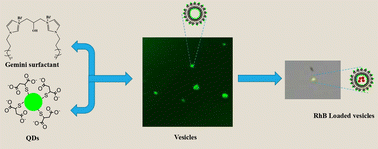Study of the self-assembly of a gemini surfactant induced by anionic QDs in aqueous solution†
Abstract
The interaction of anionic quantum dots (QDs) with a gemini surfactant (1,1′-(propane-1,3-diyl-2-ol)bis(3-hexadecyl-1H-imidazol-3-ium)) bromide [C16Im-3OH-ImC16]Br2 in water has been investigated, yielding a unique class of luminescent self-assemblies. Instead of engaging with the QDs directly, the dimeric surfactant self-associates into micelles first. After adding [C16Im-3OH-ImC16]Br2 to aqueous solutions containing QDs, two types of structural formations, supramolecular and vesicles, were confirmed. A variety of intermediary structures, including cylindrical and oligomers of vesicles are found to be present. Field-emission scanning electron microscopy (FESEM) and confocal laser scanning microscopy (CLSM) were used to investigate the luminescent and morphological properties of the self-assembled nanostructures in the first turbid (Ti) and second turbid (Tf) regions. FESEM images show discrete spherical vesicles in the mixture's Ti and Tf regions. The presence of self-assembled QDs in these spherical vesicles makes them naturally luminescent, according to CLSM data. Because the QDs are equally distributed in the micelles, their self-quenching is greatly reduced and their luminescence is effectively sustained. We have also demonstrated the successful encapsulation of dye rhodamine B (RhB) into these self-assembled vesicles using CLSM without any structural disturbance. The discovery of luminescent self-assembled vesicles from a QD-[C16Im-3OH-ImC16]Br2 combination might lead to new potential in controlled release drug delivery and sensing.



 Please wait while we load your content...
Please wait while we load your content...